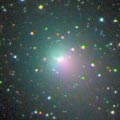
|
Now it is so bright as 8.2 mag (Aug. 21, Juan Jose Gonzalez). It will be observable at 8-10 mag in good condition for a long time until late autumn.
Date(TT) R.A. (2000) Decl. Delta r Elong. m1 Best Time(A, h)
Aug. 29 19 54.33 15 25.1 2.381 3.169 134 8.1 21:22 ( 0, 70)
Sept. 5 19 42.80 11 53.5 2.452 3.181 128 8.2 20:43 ( 0, 67)
|
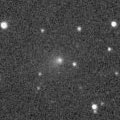
|
Now it is so bright as 9.8 mag (Aug. 21, Juan Jose Gonzalez). It keeps observable for a long time until 2010 February. It will keep 9 mag until the end of 2009. But in the Northern Hemisphere, it keeps very low after this. It locates a bit higher in the Southern Hemisphere.
Date(TT) R.A. (2000) Decl. Delta r Elong. m1 Best Time(A, h)
Aug. 29 14 30.11 -16 28.1 1.553 1.448 64 9.8 19:59 ( 58, 13)
Sept. 5 14 49.39 -18 13.5 1.564 1.424 62 9.6 19:48 ( 56, 13)
|
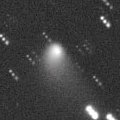
|
It brightened up to 9.8 mag on June 13 (Marco Goiato). Now it is not observable. But it keeps as bright as 10-11 mag for a long time untio 2010 spring. In the Northern Hemisphere, it will appear in the morning sky in early October, then it keeps observable at 10 mag in good condition for a long time. In the Southern Hemisphere, it will locate extremely low only after this.
Date(TT) R.A. (2000) Decl. Delta r Elong. m1 Best Time(A, h)
Aug. 29 9 46.02 4 5.1 3.274 2.296 12 9.7 4:01 (256,-13)
Sept. 5 9 59.24 4 44.8 3.246 2.282 14 9.7 4:08 (258, -8)
|
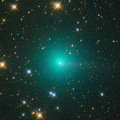
|
It brightened up to 6.7 mag in June (June 9, Marco Goiato). Now it is fading, but still bright as 9.5 mag (Aug. 21, Juan Jose Gonzalez). However, it will be unobservable soon. It will appear in the morning sky again at 13 mag in November. It may be visible visually again.
Date(TT) R.A. (2000) Decl. Delta r Elong. m1 Best Time(A, h)
Aug. 29 12 47.68 3 16.1 2.734 1.989 34 10.4 19:59 ( 90, 6)
Sept. 5 12 51.34 4 12.8 2.850 2.028 29 10.7 19:48 ( 93, 3)
|
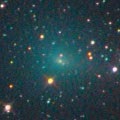
|
It brightened up to 8.8 mag in May and June (May 19, Juan Jose Gonzalez). Now it is still bright as 10.4 mag (Aug. 21, Juan Jose Gonzalez). It will be bright at 9-10 mag for a long time until autumn.
Date(TT) R.A. (2000) Decl. Delta r Elong. m1 Best Time(A, h)
Aug. 29 22 48.72 -14 12.2 0.830 1.837 173 10.4 0:21 ( 0, 41)
Sept. 5 22 44.65 -14 54.8 0.868 1.871 171 10.7 23:45 ( 0, 40)
|
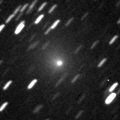
|
It brightened up to 8.5 mag in May and June (May 26, Juan Jose Gonzalez). Now it is fading, but still bright as 10.7 mag (Aug. 22, Marco Goiato). It will never be observable again in the Northern Hemisphere. In the Southern Hemisphere, it keeps observable for a long time after this in the evening sky.
Date(TT) R.A. (2000) Decl. Delta r Elong. m1 Best Time(A, h)
Aug. 29 11 30.47 -44 16.2 2.026 1.674 55 10.4 19:59 ( 56,-33)
Sept. 5 12 0.29 -47 14.8 2.095 1.745 56 10.7 19:48 ( 51,-32)
|
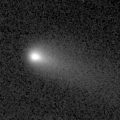
|
It is already so bright as 10.1 mag (Aug. 19, Juan Jose Gonzalez). It will be observable at 10-11 mag in a good condition for a long time from summer to winter.
Date(TT) R.A. (2000) Decl. Delta r Elong. m1 Best Time(A, h)
Aug. 29 3 59.31 -3 16.5 0.578 1.232 98 11.0 4:01 (327, 46)
Sept. 5 4 26.93 -3 32.4 0.577 1.225 97 10.9 4:08 (329, 47)
|
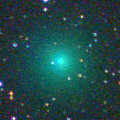
|
It was bright as 8-9 mag in April and May. Although it had been unobservable for a while, now it is appearing in the morning sky. It should be bright as 12 mag still now. It will be fading slowly in the low sky after this. In the Southern Hemisphere, it keeps observable in good condition for a long time.
Date(TT) R.A. (2000) Decl. Delta r Elong. m1 Best Time(A, h)
Aug. 29 7 50.48 0 48.9 2.735 2.075 40 11.9 4:01 (275, 9)
Sept. 5 7 55.89 -2 9.0 2.728 2.148 45 12.0 4:08 (282, 13)
|

|
It must have reached up to 11 mag in summer. However, the condition of this apparition is worst. We can not observe it at all.
Date(TT) R.A. (2000) Decl. Delta r Elong. m1 Best Time(A, h)
Aug. 29 10 39.69 15 14.3 2.239 1.240 6 12.0 19:59 (118,-12)
Sept. 5 11 5.01 12 53.9 2.258 1.262 6 12.3 19:48 (115,-12)
|

|
First return of a new bright periodic comet. It was observed as an asteroid in June. Now it is so bright as 12.3 mag (Aug. 31, Juan Jose Gonzalez). In the Northern Hemisphere, it keeps observable in a good condition after this. However, it will fade out rapidly, and will be fainter than 18 mag in October.
Date(TT) R.A. (2000) Decl. Delta r Elong. m1 Best Time(A, h)
Aug. 29 8 19.85 14 32.8 0.287 0.782 32 13.2 4:01 (259, 10)
Sept. 5 8 9.56 18 37.6 0.351 0.783 41 13.6 4:08 (262, 21)
|
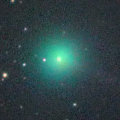
|
It has been observed bright as 8-9 mag from April to June. Now it is fading. It was still bright as 11.0 mag in July (July 12, Marco Goiato). However, no observations have been reported since August. So it may have faded out rapidly. In the Southern Hemisphere, it keeps observable in a good condition for a long time. In the Northern Hemisphere, it will never be observable again.
Date(TT) R.A. (2000) Decl. Delta r Elong. m1 Best Time(A, h)
Aug. 29 10 6.14 -50 31.4 2.618 2.290 60 13.2 4:01 (310,-41)
Sept. 5 10 15.40 -50 33.2 2.743 2.370 58 13.4 4:08 (311,-37)
|

|
It brightened up to 11 mag in spring and summer. Now it is not observable. It will appear in the morning sky at 15 mag in early 2010. But it locates somewhat low in the Northern Hemisphere.
Date(TT) R.A. (2000) Decl. Delta r Elong. m1 Best Time(A, h)
Aug. 29 12 47.49 -5 31.4 2.909 2.194 37 13.3 19:59 ( 83, 0)
Sept. 5 13 1.13 -7 3.8 2.959 2.202 34 13.3 19:48 ( 82, -1)
|

|
Now it is not observable. It will appear in the morning sky in September.
Date(TT) R.A. (2000) Decl. Delta r Elong. m1 Best Time(A, h)
Aug. 29 9 9.96 16 28.5 7.091 6.156 20 14.2 4:01 (251, 1)
Sept. 5 9 14.90 16 2.5 7.047 6.158 26 14.2 4:08 (255, 7)
|
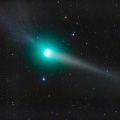
|
It passed near by the earth in late February, and it reached up to 4.9 mag (Feb. 23, Juan Jose Gonzalez). It had been unobservable for a while, but it is appearing in the morning sky again. it is still bright as 13.7 mag and visible visually (Aug. 28, Jakub Cerny). In the Northern Hemisphere, it is observable at 15 mag in good condition from autumn to winter.
Date(TT) R.A. (2000) Decl. Delta r Elong. m1 Best Time(A, h)
Aug. 29 7 19.80 20 56.2 3.944 3.339 47 14.2 4:01 (262, 26)
Sept. 5 7 19.99 20 52.9 3.910 3.413 53 14.3 4:08 (266, 33)
|
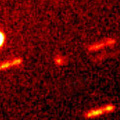
|
Now it is 15.9 mag (Aug. 29, H. Sato). It will be getting higher after this. It will be observable bright as 9-10 mag in a good condition for a long time from winter to spring. It keeps observable until 2010 autumn when it fades down to 16 mag.
Date(TT) R.A. (2000) Decl. Delta r Elong. m1 Best Time(A, h)
Aug. 29 7 37.76 19 52.0 2.930 2.294 42 14.7 4:01 (260, 22)
Sept. 5 7 52.38 19 17.8 2.833 2.253 46 14.5 4:08 (263, 25)
|
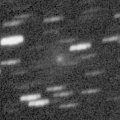
|
Appearing in the morning sky. Now it is 12.8 mag and visible visually (July 25, Juan Jose Gonzalez). It will be getting higher gradually while fading slowly after this.
Date(TT) R.A. (2000) Decl. Delta r Elong. m1 Best Time(A, h)
Aug. 29 7 47.64 24 30.2 2.260 1.644 41 14.5 4:01 (255, 22)
Sept. 5 8 5.61 23 23.0 2.264 1.689 43 14.7 4:08 (258, 25)
|
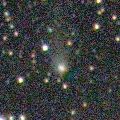
|
It brightened up to 11.5 mag in last summer (Aug. 4, Marco Goiato). Now it is 15.9 mag (Aug. 12, H. Sato). It keeps observable in good condition for a long time in the Southern Hemisphere. It will be observable again also in the Northern Hemisphere after September. It will keep 15-16 mag until next spring.
Date(TT) R.A. (2000) Decl. Delta r Elong. m1 Best Time(A, h)
Aug. 29 6 36.63 -37 53.5 4.119 3.927 72 14.5 4:01 (316, -3)
Sept. 5 6 38.58 -38 19.4 4.123 3.977 74 14.6 4:08 (321, 1)
|

|
It was observed as bright as 13 mag in spring and summer. It will be too low to observe soon. It will brighten up to 12-13 mag in 2010 summer.
Date(TT) R.A. (2000) Decl. Delta r Elong. m1 Best Time(A, h)
Aug. 29 13 17.16 -3 0.3 3.327 2.685 43 14.6 19:59 ( 81, 8)
Sept. 5 13 27.17 -4 19.6 3.368 2.669 39 14.6 19:48 ( 80, 6)
|

|
It brightened up to 9.8 mag in winter (Dec. 28, Juan Jose Gonzalez). It faded down to 12.5 mag in May (May 26, Juan Jose Gonzalez), and became unobservable. Now it is not observable, however, it will be observable in good condition again in winter at 15 mag. Then it may be still visible visually.
Date(TT) R.A. (2000) Decl. Delta r Elong. m1 Best Time(A, h)
Aug. 29 9 33.21 15 8.9 5.301 4.333 14 14.6 4:01 (249, -4)
Sept. 5 9 39.62 14 16.5 5.321 4.387 19 14.7 4:08 (253, 1)
|
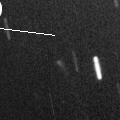
|
Now it is 14.5 mag (July 30, H. Sato). It keeps observable in good condition at 15 mag until late autumn.
Date(TT) R.A. (2000) Decl. Delta r Elong. m1 Best Time(A, h)
Aug. 29 0 23.81 25 34.3 3.126 3.910 135 14.9 1:56 ( 0, 81)
Sept. 5 0 16.17 26 47.5 3.080 3.915 141 14.9 1:21 ( 0, 82)
|

|
Now it is 15.2 mag (Aug. 3, H. Sato). It passes the perihelion in September, and now it is brightest. It keeps observable in good condition in the Southern Hemisphere. It is not observable now in the Northern Hemisphere. But it will appear in the evening sky at the end of September, and then it will be getting higher while fading.
Date(TT) R.A. (2000) Decl. Delta r Elong. m1 Best Time(A, h)
Aug. 29 14 40.09 -56 20.5 0.806 1.217 83 15.0 19:59 ( 28,-13)
Sept. 5 15 31.21 -55 38.3 0.779 1.210 84 14.9 19:48 ( 25, -9)
|
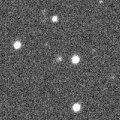
|
Now it is 15.3 mag (Aug. 22, H. Sato). It keeps 15 mag until 2010, and will be observable for a long time in good condition.
Date(TT) R.A. (2000) Decl. Delta r Elong. m1 Best Time(A, h)
Aug. 29 15 50.24 44 30.4 2.859 2.799 76 15.3 19:59 (119, 58)
Sept. 5 15 42.73 41 42.6 2.935 2.792 71 15.3 19:48 (114, 54)
|

|
Now it is 14.9 mag (Aug. 26, H. Sato). It keeps 15 mag until winter. It keeps observable in a good condition in the Southern Hemisphere. But in the Northern Hemisphere, it will be getting lower gradually, and it is only observable until late autumn.
Date(TT) R.A. (2000) Decl. Delta r Elong. m1 Best Time(A, h)
Aug. 29 0 14.87 -5 39.3 1.949 2.889 153 15.6 1:47 ( 0, 50)
Sept. 5 0 6.87 -9 50.8 1.880 2.856 162 15.4 1:12 ( 0, 45)
|
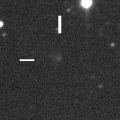
|
Now it is 16.2 mag (Aug. 13, Ken-ichi Kadota), brightening as expected. It will reach up to 12 mag in 2012, and will be observable visually at 12-13 mag for a long time from 2011 to 2013. In 2009, it is observable in good condition at 16 mag from summer to autumn. In the Northern Hemisphere, the comet will be low around its brightest seasons.
Date(TT) R.A. (2000) Decl. Delta r Elong. m1 Best Time(A, h)
Aug. 29 22 18.31 4 18.1 7.616 8.599 165 15.8 23:46 ( 0, 59)
Sept. 5 22 13.64 3 52.9 7.584 8.562 165 15.7 23:14 ( 0, 59)
|

|
It brightened up to 13 mag from 2007 to 2009, and it was observed visually for a long time. It will fade out gradually after this. But it keeps 16 mag until 2010 spring, and 17 mag until 2010 autumn. Although it becomes low in autumn temporarily, it keeps observable in good condition from winter to summer.
Date(TT) R.A. (2000) Decl. Delta r Elong. m1 Best Time(A, h)
Aug. 29 13 5.55 31 55.5 7.710 6.998 42 15.8 19:59 (113, 24)
Sept. 5 13 6.74 31 30.6 7.777 7.027 39 15.8 19:48 (114, 21)
|

|
Now it is 15.7 mag (Aug. 31, Michael Jager). It will brighten rapidly after this. It will reach to 12 mag and become visible visually in winter. In the Northern Hemisphere, it keeps observable in good condition for a long time after this until 2010 spring when it fades out.
Date(TT) R.A. (2000) Decl. Delta r Elong. m1 Best Time(A, h)
Aug. 29 4 45.43 13 36.0 2.079 2.215 84 16.0 4:01 (297, 53)
Sept. 5 4 57.04 13 29.8 1.983 2.193 87 15.8 4:08 (303, 57)
|
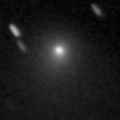
|
It reached to 10.9 mag in 2008 spring (May 11, Marco Goiato). It is fading slowly, but still bright as 15.0 mag (Aug. 20, H. Sato). Although it becomes low in winter temporarily, it keeps observable for a long time until 2010 spring when it becomes fainter than 18 mag.
Date(TT) R.A. (2000) Decl. Delta r Elong. m1 Best Time(A, h)
Aug. 29 16 11.86 31 40.7 4.976 4.925 81 15.8 19:59 ( 93, 61)
Sept. 5 16 15.47 30 55.0 5.087 4.976 77 15.9 19:48 ( 93, 58)
|
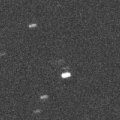
|
New periodic comet. It has already passed the perihelion in late June. But unexpectedly, it keeps unusual brightening very rapidly after that. Now it became bright as 15.0 mag (July 30, D. Chestnov). It keeps observable in the evening low sky for a while after this. But it may fade out very rapidly.
Date(TT) R.A. (2000) Decl. Delta r Elong. m1 Best Time(A, h)
Aug. 29 14 12.02 -8 16.8 1.791 1.522 58 16.0 19:59 ( 68, 16)
Sept. 5 14 34.12 -10 7.3 1.861 1.562 57 16.4 19:48 ( 65, 15)
|
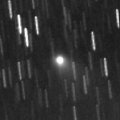
|
It reached up to 12.6 mag and became visible visually in June and July (June 25, Katsumi Yoshimoto). However, it is fading rapidly after August. It has already faded down to 16.8 mag (Aug. 16, Ken-ichi Kadota). It will be fainter than 18 mag in October.
Date(TT) R.A. (2000) Decl. Delta r Elong. m1 Best Time(A, h)
Aug. 29 19 2.44 3 15.9 0.911 1.718 126 16.1 20:32 ( 0, 58)
Sept. 5 19 10.84 2 44.0 1.001 1.767 123 16.5 20:13 ( 0, 58)
|

|
Appearing in the morning sky. It has not been recovered yet. But it must have already brightened up to 16.5 mag. It will be getting higher rapidly after this, and will be observable in good condition at 16 mag in autumn.
Date(TT) R.A. (2000) Decl. Delta r Elong. m1 Best Time(A, h)
Aug. 29 6 2.57 31 29.3 2.222 2.021 65 16.3 4:01 (259, 46)
Sept. 5 6 15.86 33 34.6 2.164 2.041 69 16.2 4:08 (258, 51)
|

|
Now it is brightest, and it will be fading after October. It keeps observable until January when it becomes fainter than 18 mag. It locates somewhat low in the Northern Hemisphere.
Date(TT) R.A. (2000) Decl. Delta r Elong. m1 Best Time(A, h)
Aug. 29 1 28.67 -16 37.7 2.117 2.928 135 16.8 3:00 ( 0, 38)
Sept. 5 1 29.43 -18 49.3 2.076 2.927 140 16.8 2:34 ( 0, 36)
|
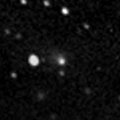
|
It brightened up to 15-16 mag in 2008 summer. Now it is 17.8 mag (Aug. 26, Katsumi Yoshimoto). It keeps observable at 17 mag in good condition for a long time until winter.
Date(TT) R.A. (2000) Decl. Delta r Elong. m1 Best Time(A, h)
Aug. 29 3 47.08 30 16.4 2.792 3.040 94 17.0 4:01 (281, 73)
Sept. 5 3 51.17 31 4.9 2.715 3.055 99 17.0 4:08 (288, 79)
|
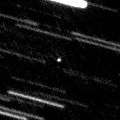
|
It passed the perihelion in June, but it was not observable, too close to the sun. Although it was predicted to be 13.5 mag, the STEREO spacecraft revealed that it brightened up to 10-11 mag, much brighter than expected. Now it is 16.4 mag (Aug. 23, C00). It keeps observable at 16-17 mag until late autumn.
Date(TT) R.A. (2000) Decl. Delta r Elong. m1 Best Time(A, h)
Aug. 29 4 30.91 46 36.7 1.151 1.436 82 17.1 4:01 (234, 64)
Sept. 5 4 22.77 47 59.6 1.128 1.516 90 17.1 4:08 (223, 70)
|
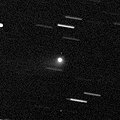
|
It reached up to 14 mag in 2008 autumn. It is still bright as 16.0 mag (July 30, H. Sato). It keeps observable around 17 mag in a good condition for a while.
Date(TT) R.A. (2000) Decl. Delta r Elong. m1 Best Time(A, h)
Aug. 29 22 23.26 17 46.4 3.919 4.839 152 17.4 23:51 ( 0, 73)
Sept. 5 22 12.82 16 49.8 3.956 4.883 154 17.5 23:13 ( 0, 72)
|
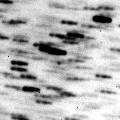
|
Now it is 16.7 mag (Aug. 14, Katsumi Yoshimoto). The condition is good in this apparition. It will approach to the earth down to 0.38 A.U., and will be observable in good condition at 16.5 mag in November. It keeps observable until that time after this. But it locates somewhat low in the Northern Hemisphere.
Date(TT) R.A. (2000) Decl. Delta r Elong. m1 Best Time(A, h)
Aug. 29 16 20.85 -18 46.5 0.672 1.222 90 17.6 19:59 ( 35, 28)
Sept. 5 16 32.26 -18 49.0 0.657 1.172 86 17.6 19:48 ( 36, 28)
|
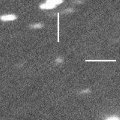
|
It keeps observable at 17 mag for a long time from 2010 to 2012. Now it is 18.5 mag (Aug. 25, W. Hasubick), a bit fainter than this ephemeris.
Date(TT) R.A. (2000) Decl. Delta r Elong. m1 Best Time(A, h)
Aug. 29 3 44.44 20 42.8 8.732 8.913 97 17.7 4:01 (306, 68)
Sept. 5 3 42.30 20 43.3 8.591 8.895 104 17.7 4:08 (327, 73)
|

|
Now it is 17.3 mag (Aug. 23, Ken-ichi Kadota). It keeps observable at 17-18 mag for a long time until 2011.
Date(TT) R.A. (2000) Decl. Delta r Elong. m1 Best Time(A, h)
Aug. 29 4 33.25 66 48.3 5.255 5.193 81 17.8 4:01 (200, 54)
Sept. 5 4 34.22 68 32.5 5.155 5.174 85 17.7 4:08 (194, 54)
|
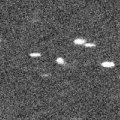
|
Now it is 17.5 mag (Aug. 14, Michael Jager). It will be getting lower in the evening sky after this. But it will be observable at 17 mag from spring to summer in 2010.
Date(TT) R.A. (2000) Decl. Delta r Elong. m1 Best Time(A, h)
Aug. 29 16 12.28 38 37.6 3.613 3.591 80 17.8 19:59 (107, 62)
Sept. 5 16 17.77 36 14.6 3.627 3.564 78 17.8 19:48 (103, 60)
|

|
Now it is 17.7 mag (Sept. 5, H. Sato). It will reach up to 15.5 mag. It keeps observable in good condition all through the time until next spring when it becomes fainter than 18 mag.
Date(TT) R.A. (2000) Decl. Delta r Elong. m1 Best Time(A, h)
Aug. 29 4 34.67 8 21.6 1.281 1.596 87 18.1 4:01 (306, 51)
Sept. 5 4 55.44 8 24.2 1.204 1.556 88 17.8 4:08 (310, 53)
|
|
![]()
 222P/2009 MB9 ( LINEAR )
222P/2009 MB9 ( LINEAR ) C/2009 G1 ( STEREO )
C/2009 G1 ( STEREO ) 116P/Wild 4
116P/Wild 4 29P/Schwassmann-Wachmann 1
29P/Schwassmann-Wachmann 1 C/2007 N3 ( Lulin )
C/2007 N3 ( Lulin ) 81P/Wild 2
81P/Wild 2 64P/Swift-Gehrels
64P/Swift-Gehrels C/2007 G1 ( LINEAR )
C/2007 G1 ( LINEAR ) 65P/Gunn
65P/Gunn C/2006 OF2 ( Broughton )
C/2006 OF2 ( Broughton ) C/2008 P1 ( Garradd )
C/2008 P1 ( Garradd ) (3552) Don Quixote
(3552) Don Quixote C/2008 N1 ( Holmes )
C/2008 N1 ( Holmes ) C/2009 O4 ( Hill )
C/2009 O4 ( Hill ) C/2006 S3 ( LONEOS )
C/2006 S3 ( LONEOS ) C/2005 L3 ( McNaught )
C/2005 L3 ( McNaught ) 118P/Shoemaker-Levy 4
118P/Shoemaker-Levy 4 C/2006 Q1 ( McNaught )
C/2006 Q1 ( McNaught ) P/2009 K1 ( Gibbs )
P/2009 K1 ( Gibbs ) P/2009 L2 ( Yang-Gao )
P/2009 L2 ( Yang-Gao ) P/2003 A1 ( LINEAR )
P/2003 A1 ( LINEAR ) P/2009 Q5 ( McNaught )
P/2009 Q5 ( McNaught ) 47P/Ashbrook-Jackson
47P/Ashbrook-Jackson (3200) Phaethon
(3200) Phaethon C/2007 U1 ( LINEAR )
C/2007 U1 ( LINEAR ) 107P/(4015) Wilson-Harrington
107P/(4015) Wilson-Harrington C/2008 S3 ( Boattini )
C/2008 S3 ( Boattini ) C/2007 VO53 ( Spacewatch )
C/2007 VO53 ( Spacewatch ) C/2009 K2 ( Catalina )
C/2009 K2 ( Catalina ) P/2009 Q4 ( Boattini )
P/2009 Q4 ( Boattini )![]()





























